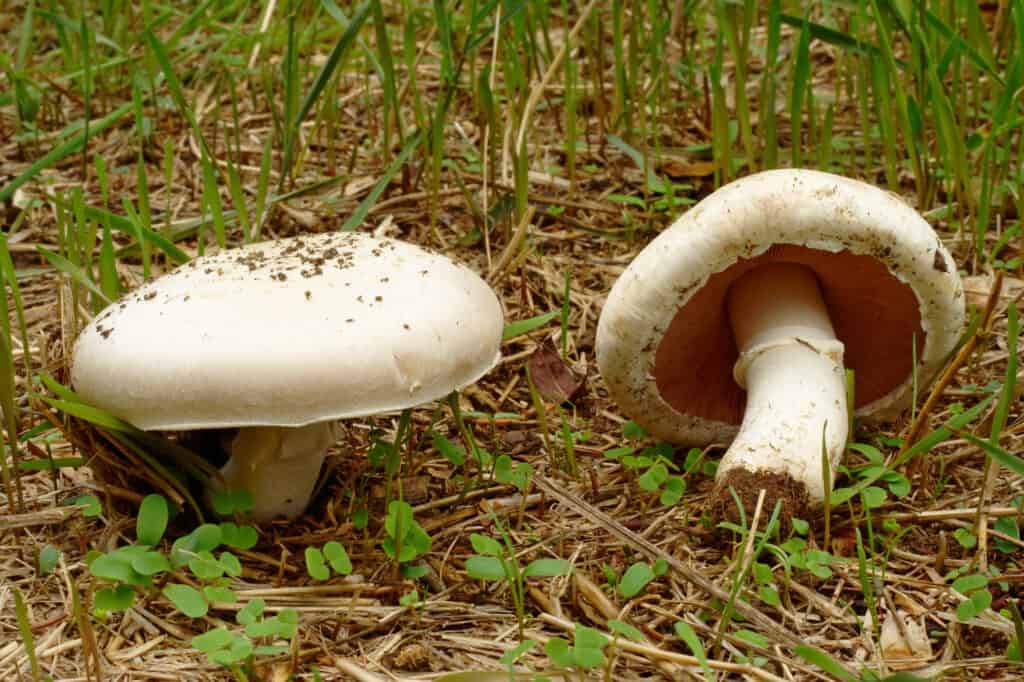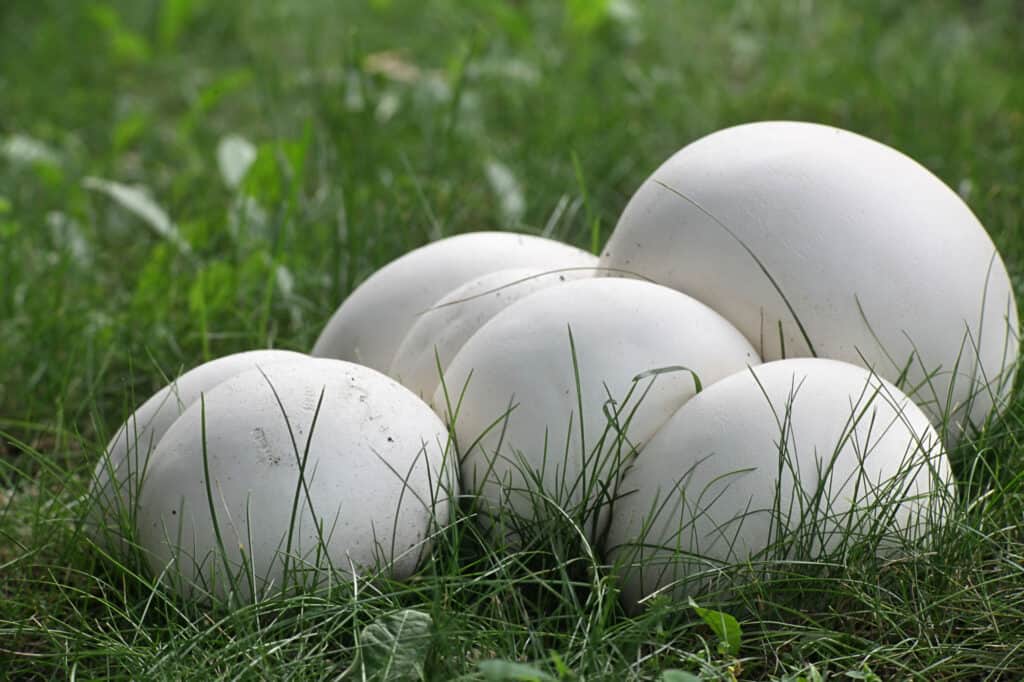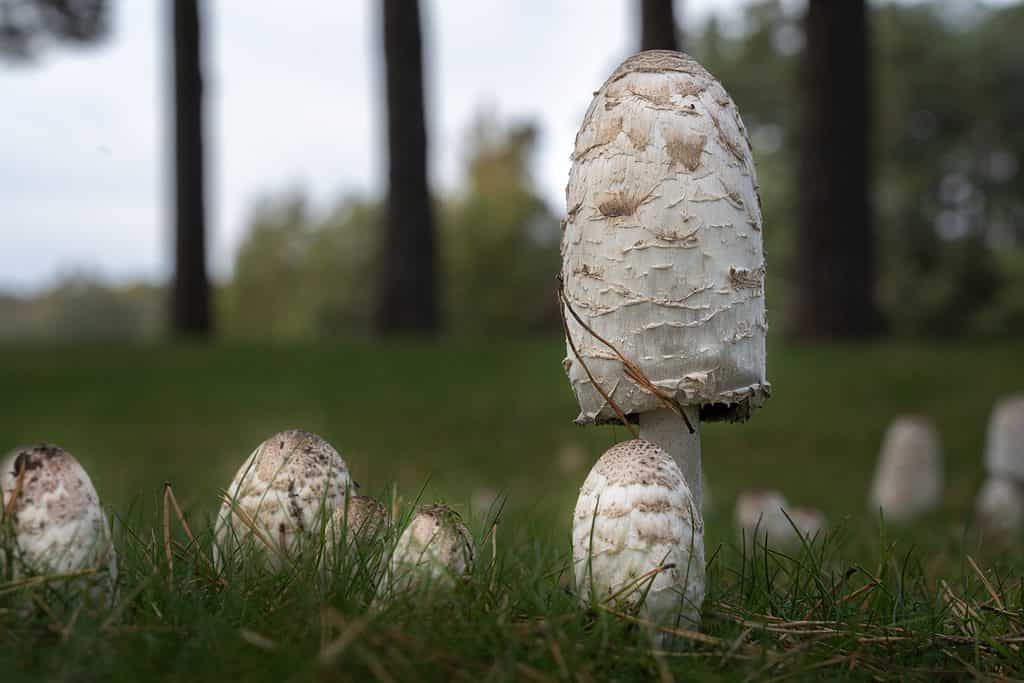Mushrooms growing from grass often indicate a healthy lawn or meadow. Soils rich in fungi represent a robust, living soil ecosystem. You may notice mushrooms growing in your yard or a local meadow. Are you curious about these mushrooms that grow in the grass? In this guide, we’ll discover three species of North American mushrooms that grow in grass.
Read on to learn more!
Mushrooms that Grow in Grass: Meadow Mushroom (Agaricus andrewii)
A close, wild relative of store-bought button mushrooms (Agaricus bisporus), the common name “meadow mushroom” represents several almost identical-looking species from North America and Eurasia. Until 2016, all species of grassland mushrooms in North America that fit the description of the meadow mushroom were lumped together as Agaricus campestris. However, Recent genetic analysis revealed that Agaricus campestris likely only occurs in Europe, although some may debate the occasional occurrence in the Rockies. Most North American specimens, formally referred to as Agaricus campestris, are unique species. One such North American meadow mushroom species is Agaricus andrewii, which grows widely east of the Great Plains.
Morphology
This species is so similar to Agaricus campestris that the most reliable way to distinguish the two comes from comparing the spore sizes under a microscope.
Cap: Like other mushrooms closely related to A. campestris, Agaricus andrewii features a whitish cap that begins convex and matures into broadly convex. With maturity, the cap tends to feature a bit of off-white discoloration. The cap can reach up to about 4.5 inches across.
Gills: The gills start pink and turn brown with maturity. When young, the gills are covered by a white partial veil, a thin, membranous protective tissue found underneath the cap of some immature species. The spore print from the gills is dark brown.
Stipe: The stipe, or stem, of Agaricus andrewii is white to off-white, features a slightly tapered base, and typically has a fragile white partial veil ring around the upper stipe. This partial veil ring is left as a remnant when the cap expands and breaks the partial veil as the mushroom matures. With age, the stipe may discolor slightly brown in some places.
Flesh: The flesh of Agaricus andrewii is white and does not change color when sliced.
Ecology
Like its close relatives, Agaricus andrewii is saprobic. This means the fungus obtains its nutrients from breaking down dead organic matter. As decomposers, saprobic fungi contribute to vital nutrient recycling and carbon sequestration. Corpinus comatus (mentioned later in this article) is also a nematophagous fungus, which means it can prey upon and digest certain species of nematodes. Specifically, The filamentous, underground portion of Coprinus comatus preys upon Panagrellus redivivus and Meloidogyne arenaria. It typically grows in lawns and meadows in scattered groups, arcs, or charismatic fairy rings throughout the fall.
Edibility
Agaricus andrewii is a good edible. However, it is not recommended for beginner foragers due to its similarity with several poisonous mushrooms, specifically in the Agaricus and Amanita genera.

and
Agaricus andrewiilook pretty much identical to the naked eye.
©iStock.com/fedsax
Mushrooms that Grow in Grass: Giant Puffball (Calvatia gigantea)
An incredible sight, the giant puffball (Calvatia gignatea) is a spectacular mushroom widely distributed in grasslands and forests east of the Great Plains. Averaging the size of a soccer ball, these unique mushrooms are a delight to stumble upon.
Morphology
The giant puffball is similar in appearance to other true puffballs of the Calvatia, Calbovista, and Lycoperdon genera but grows much larger.
Fruiting body: At maturity, this fungus’s ball-shaped, white fruiting body averages 8-20 inches across. However, people have reported even larger robust specimens. According to the Guinness Book of World Records, the largest ever recorded giant puffball measured almost 3 feet across and weighed 48lbs, 8 ounces.
When young, the fruiting body is bright white and finely velvety. As it ages, it loses its velvetiness and becomes bald or dotted with fine scales. The flesh of young specimens is white and softly spongy. The flesh becomes olive-yellow as the mushroom matures. At maturity, the flesh becomes a brownish spore dust, and the outer skin is notably frail.
Ecology
Mycologists don’t fully understand the ecological relations of the giant puffball. This species is saprobic but may also exhibit a mutualistic relationship with the roots of trees. To date, no successful cultivation of Calvatia gigantea has been documented, suggesting it may have a more complicated life cycle than strictly saprobic species.
These gigantic mushrooms appear from summer through early fall. They typically grow alone or scattered in grassy areas or at the edge of woodlands.
Edibility
The giant puffball is a delicious edible mushroom when the flesh is still white. If you find a small specimen, it’s essential to confirm its identity by cutting the mushroom vertically in half. Several deadly poisonous species in the Amanita genus, such as Amanita bisporigera, can look similar to small specimens of Calvatia gigantea when the amanita is in its immature, egg-like form. This egg-like structure is a universal veil that fully encases the developing mushroom. When you cut an amanita egg vertically in half, you can see the newborn cap, stipe, and gills. When you cut a small Calvatia gigantea in half vertically, you should only see solid white, spongy flesh.

Some people joke about these mushrooms as “tofu of the woods” because they soak up other flavors so well.
©Henri Koskinen/Shutterstock.com
Mushrooms that Grow in Grass: Shaggy Mane Mushroom (Coprinus comatus)
Part of a group of mushrooms known as inky caps, the shaggy mane mushroom (Coprinus comatus) features a strange spore dispersal strategy called deliquescence. Deliquescence describes the auto-digestive behavior of the shaggy mane mushroom in which enzymes break down its cap, beginning at the edges, and turn the material into a black, inky liquid. As the elongated cap of the shaggy mane mushroom is eaten away through this process, the mature spores are exposed and able to spread.
Morphology
As its common name suggests, Coprinus comatus is shaggy or wooly.
Cap: Coprinus comatus features a cap covered in shaggy scales. When young, the cap and scales are white to off-white. The cap and scales darken as the mushroom matures, starting at the margins. Initially, the structure of the cap is tightly cylindrical. The cap becomes bell-shaped as it grows. When young, the cap can measure up to 8 inches long. Through the auto-digestion process, it typically measures only about 2 inches long at maturity and is grey-black.
Gills: The gills of the shaggy mane mushroom are accessible from the stem and white when young. With freely attached gills, there is a thin line of space between where the gills start and where the cap connects to the stipe. As the mushroom matures, the gills become pinkish, black, and inky. The spore print of this species is black.
Stipe: The stipe of Coprinus comatus can measure up to 8 inches tall. It is brittle, smooth, and initially whitish. The inside of the stem is hollow, mainly with fibrous strands. Through the process of deliquescence, the stipe becomes stained black.
Ecology
The shaggy mane mushroom is saprobic and grows alone, in dense clusters, wandering lines, or fairy circles. This species obtains nutrients from decaying organic matter in grass and mulch. Additionally, studies have revealed It may appear in grass, along paths, or mulched areas from summer through fall and is widely distributed throughout North America.
Edibility
Coprinus comatus is excellent and edible, especially when the mushroom is still young and hasn’t yet undergone deliquescence. Once the shaggy mane begins to turn black, some folks prefer not to eat it. These mushrooms are a good one to learn for new foragers as there are no deadly inky caps. They are delicious when young and easily identifiable by their long, cone-like, and shaggy caps.

A distinct and beautiful mushroom, the shaggy mane is excellent when
crusted in parmesan
.
©UKSTUDIO/Shutterstock.com
The photo featured at the top of this post is © iStock.com/Dan Fog Madsen
The information presented on or through the Website is made available solely for general informational purposes. We do not warrant the accuracy, completeness, or usefulness of this information. Any reliance you place on such information is strictly at your own risk. We disclaim all liability and responsibility arising from any reliance placed on such materials by you or any other visitor to the Website, or by anyone who may be informed of any of its contents. None of the statements or claims on the Website should be taken as medical advice, health advice, or as confirmation that a plant, fungus, or other item is safe for consumption or will provide any health benefits. Anyone considering the health benefits of particular plant, fungus, or other item should first consult with a doctor or other medical professional. The statements made within this Website have not been evaluated by the Food and Drug Administration. These statements are not intended to diagnose, treat, cure or prevent any disease.
Thank you for reading! Have some feedback for us? Contact the AZ Animals editorial team.







